Problem-Based Learning Report: Ethical Social Work Practice Contexts
VerifiedAdded on 2020/01/23
|8
|2643
|59
Report
AI Summary
This report analyzes ethical social work practice within complex contexts, utilizing a problem-based learning (PBL) approach. The student reflects on their experience with PBL, emphasizing its role in enhancing learning through diverse resources and teamwork. The report focuses on a case study involving a client named Jacki, highlighting ethical and legal considerations, cultural competence, and the importance of support and collaboration in social work. The student's role as a critical friend is discussed, along with the contributions of other group members. The report identifies the need for a safe and supportive environment for Jacki, particularly in relation to her social isolation and financial struggles, and recommends reconnecting her with the local Aboriginal community. The report underscores the significance of considering patients' values, promoting service capability, and adapting to changing human behavior in social work. The student concludes by emphasizing the benefits of PBL in professional development and the importance of continuous learning and assessment in the field.
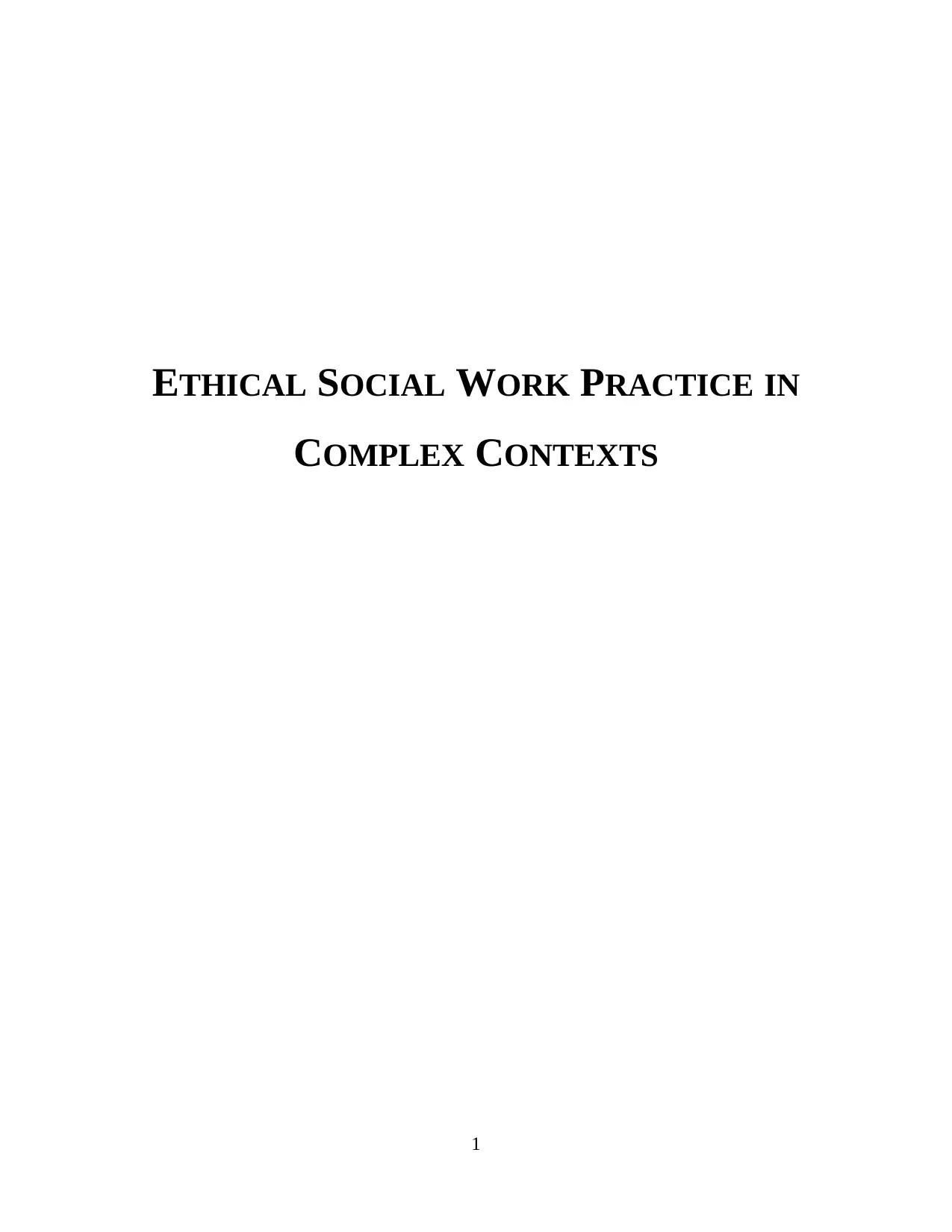
ETHICAL SOCIAL WORK PRACTICE IN
COMPLEX CONTEXTS
1
COMPLEX CONTEXTS
1
Paraphrase This Document
Need a fresh take? Get an instant paraphrase of this document with our AI Paraphraser
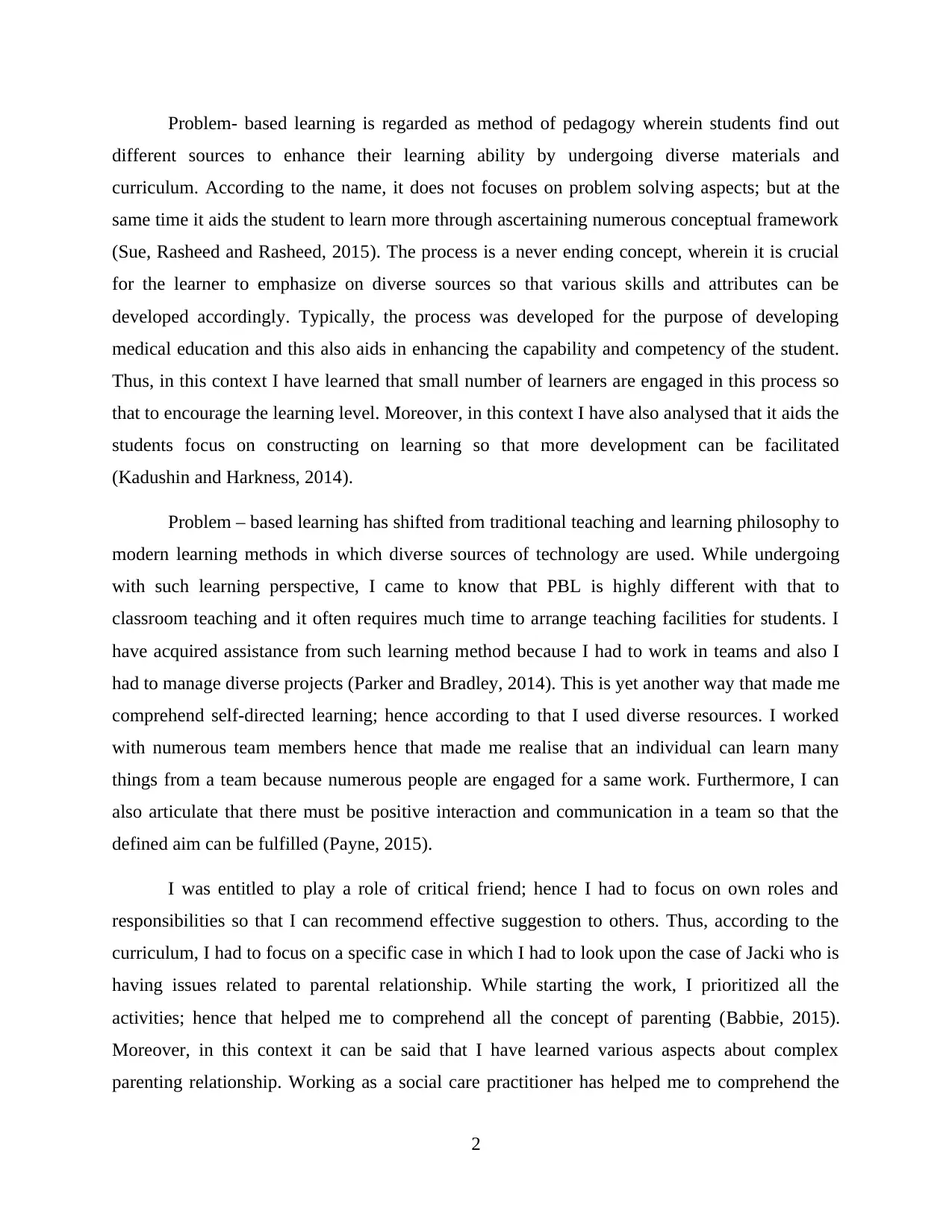
Problem- based learning is regarded as method of pedagogy wherein students find out
different sources to enhance their learning ability by undergoing diverse materials and
curriculum. According to the name, it does not focuses on problem solving aspects; but at the
same time it aids the student to learn more through ascertaining numerous conceptual framework
(Sue, Rasheed and Rasheed, 2015). The process is a never ending concept, wherein it is crucial
for the learner to emphasize on diverse sources so that various skills and attributes can be
developed accordingly. Typically, the process was developed for the purpose of developing
medical education and this also aids in enhancing the capability and competency of the student.
Thus, in this context I have learned that small number of learners are engaged in this process so
that to encourage the learning level. Moreover, in this context I have also analysed that it aids the
students focus on constructing on learning so that more development can be facilitated
(Kadushin and Harkness, 2014).
Problem – based learning has shifted from traditional teaching and learning philosophy to
modern learning methods in which diverse sources of technology are used. While undergoing
with such learning perspective, I came to know that PBL is highly different with that to
classroom teaching and it often requires much time to arrange teaching facilities for students. I
have acquired assistance from such learning method because I had to work in teams and also I
had to manage diverse projects (Parker and Bradley, 2014). This is yet another way that made me
comprehend self-directed learning; hence according to that I used diverse resources. I worked
with numerous team members hence that made me realise that an individual can learn many
things from a team because numerous people are engaged for a same work. Furthermore, I can
also articulate that there must be positive interaction and communication in a team so that the
defined aim can be fulfilled (Payne, 2015).
I was entitled to play a role of critical friend; hence I had to focus on own roles and
responsibilities so that I can recommend effective suggestion to others. Thus, according to the
curriculum, I had to focus on a specific case in which I had to look upon the case of Jacki who is
having issues related to parental relationship. While starting the work, I prioritized all the
activities; hence that helped me to comprehend all the concept of parenting (Babbie, 2015).
Moreover, in this context it can be said that I have learned various aspects about complex
parenting relationship. Working as a social care practitioner has helped me to comprehend the
2
different sources to enhance their learning ability by undergoing diverse materials and
curriculum. According to the name, it does not focuses on problem solving aspects; but at the
same time it aids the student to learn more through ascertaining numerous conceptual framework
(Sue, Rasheed and Rasheed, 2015). The process is a never ending concept, wherein it is crucial
for the learner to emphasize on diverse sources so that various skills and attributes can be
developed accordingly. Typically, the process was developed for the purpose of developing
medical education and this also aids in enhancing the capability and competency of the student.
Thus, in this context I have learned that small number of learners are engaged in this process so
that to encourage the learning level. Moreover, in this context I have also analysed that it aids the
students focus on constructing on learning so that more development can be facilitated
(Kadushin and Harkness, 2014).
Problem – based learning has shifted from traditional teaching and learning philosophy to
modern learning methods in which diverse sources of technology are used. While undergoing
with such learning perspective, I came to know that PBL is highly different with that to
classroom teaching and it often requires much time to arrange teaching facilities for students. I
have acquired assistance from such learning method because I had to work in teams and also I
had to manage diverse projects (Parker and Bradley, 2014). This is yet another way that made me
comprehend self-directed learning; hence according to that I used diverse resources. I worked
with numerous team members hence that made me realise that an individual can learn many
things from a team because numerous people are engaged for a same work. Furthermore, I can
also articulate that there must be positive interaction and communication in a team so that the
defined aim can be fulfilled (Payne, 2015).
I was entitled to play a role of critical friend; hence I had to focus on own roles and
responsibilities so that I can recommend effective suggestion to others. Thus, according to the
curriculum, I had to focus on a specific case in which I had to look upon the case of Jacki who is
having issues related to parental relationship. While starting the work, I prioritized all the
activities; hence that helped me to comprehend all the concept of parenting (Babbie, 2015).
Moreover, in this context it can be said that I have learned various aspects about complex
parenting relationship. Working as a social care practitioner has helped me to comprehend the
2
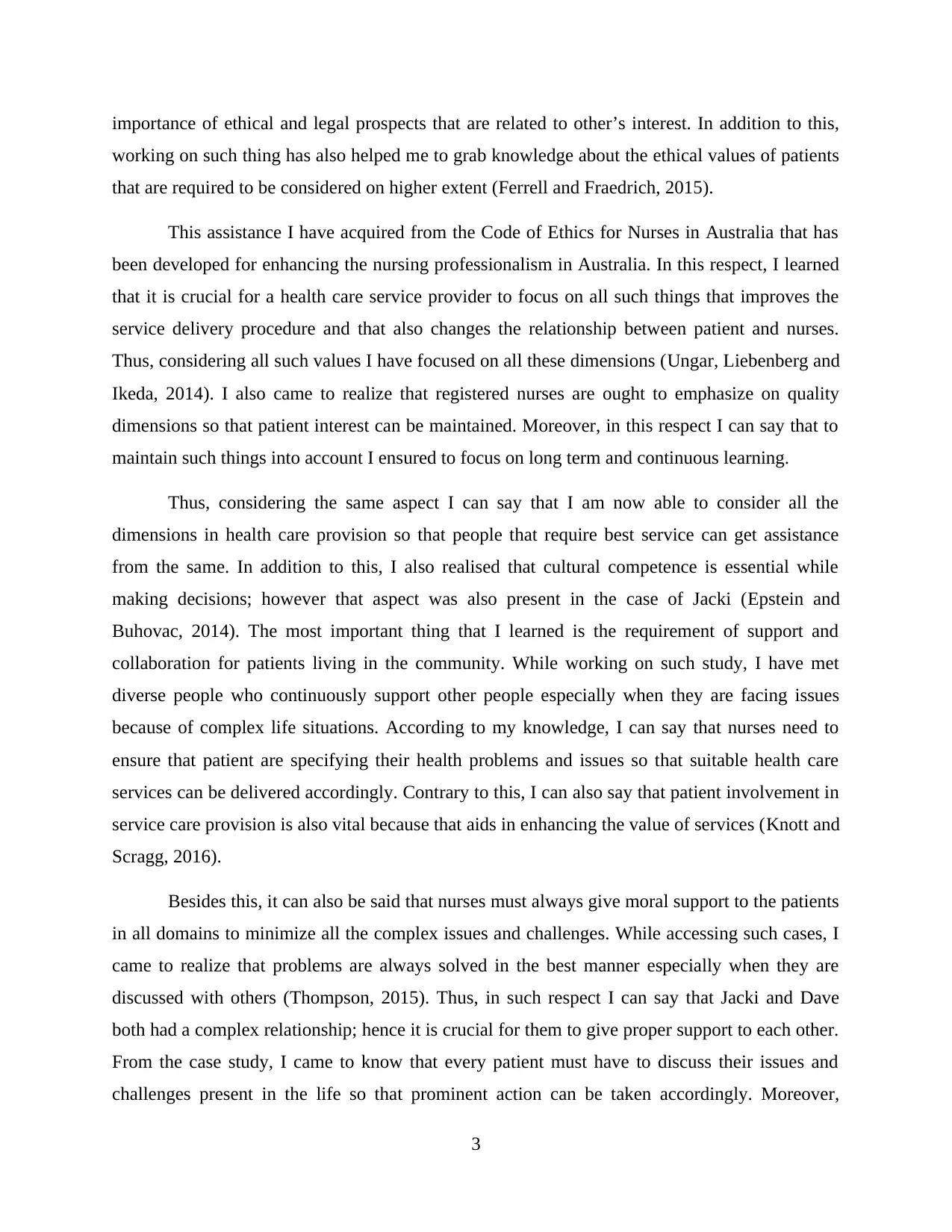
importance of ethical and legal prospects that are related to other’s interest. In addition to this,
working on such thing has also helped me to grab knowledge about the ethical values of patients
that are required to be considered on higher extent (Ferrell and Fraedrich, 2015).
This assistance I have acquired from the Code of Ethics for Nurses in Australia that has
been developed for enhancing the nursing professionalism in Australia. In this respect, I learned
that it is crucial for a health care service provider to focus on all such things that improves the
service delivery procedure and that also changes the relationship between patient and nurses.
Thus, considering all such values I have focused on all these dimensions (Ungar, Liebenberg and
Ikeda, 2014). I also came to realize that registered nurses are ought to emphasize on quality
dimensions so that patient interest can be maintained. Moreover, in this respect I can say that to
maintain such things into account I ensured to focus on long term and continuous learning.
Thus, considering the same aspect I can say that I am now able to consider all the
dimensions in health care provision so that people that require best service can get assistance
from the same. In addition to this, I also realised that cultural competence is essential while
making decisions; however that aspect was also present in the case of Jacki (Epstein and
Buhovac, 2014). The most important thing that I learned is the requirement of support and
collaboration for patients living in the community. While working on such study, I have met
diverse people who continuously support other people especially when they are facing issues
because of complex life situations. According to my knowledge, I can say that nurses need to
ensure that patient are specifying their health problems and issues so that suitable health care
services can be delivered accordingly. Contrary to this, I can also say that patient involvement in
service care provision is also vital because that aids in enhancing the value of services (Knott and
Scragg, 2016).
Besides this, it can also be said that nurses must always give moral support to the patients
in all domains to minimize all the complex issues and challenges. While accessing such cases, I
came to realize that problems are always solved in the best manner especially when they are
discussed with others (Thompson, 2015). Thus, in such respect I can say that Jacki and Dave
both had a complex relationship; hence it is crucial for them to give proper support to each other.
From the case study, I came to know that every patient must have to discuss their issues and
challenges present in the life so that prominent action can be taken accordingly. Moreover,
3
working on such thing has also helped me to grab knowledge about the ethical values of patients
that are required to be considered on higher extent (Ferrell and Fraedrich, 2015).
This assistance I have acquired from the Code of Ethics for Nurses in Australia that has
been developed for enhancing the nursing professionalism in Australia. In this respect, I learned
that it is crucial for a health care service provider to focus on all such things that improves the
service delivery procedure and that also changes the relationship between patient and nurses.
Thus, considering all such values I have focused on all these dimensions (Ungar, Liebenberg and
Ikeda, 2014). I also came to realize that registered nurses are ought to emphasize on quality
dimensions so that patient interest can be maintained. Moreover, in this respect I can say that to
maintain such things into account I ensured to focus on long term and continuous learning.
Thus, considering the same aspect I can say that I am now able to consider all the
dimensions in health care provision so that people that require best service can get assistance
from the same. In addition to this, I also realised that cultural competence is essential while
making decisions; however that aspect was also present in the case of Jacki (Epstein and
Buhovac, 2014). The most important thing that I learned is the requirement of support and
collaboration for patients living in the community. While working on such study, I have met
diverse people who continuously support other people especially when they are facing issues
because of complex life situations. According to my knowledge, I can say that nurses need to
ensure that patient are specifying their health problems and issues so that suitable health care
services can be delivered accordingly. Contrary to this, I can also say that patient involvement in
service care provision is also vital because that aids in enhancing the value of services (Knott and
Scragg, 2016).
Besides this, it can also be said that nurses must always give moral support to the patients
in all domains to minimize all the complex issues and challenges. While accessing such cases, I
came to realize that problems are always solved in the best manner especially when they are
discussed with others (Thompson, 2015). Thus, in such respect I can say that Jacki and Dave
both had a complex relationship; hence it is crucial for them to give proper support to each other.
From the case study, I came to know that every patient must have to discuss their issues and
challenges present in the life so that prominent action can be taken accordingly. Moreover,
3
⊘ This is a preview!⊘
Do you want full access?
Subscribe today to unlock all pages.

Trusted by 1+ million students worldwide
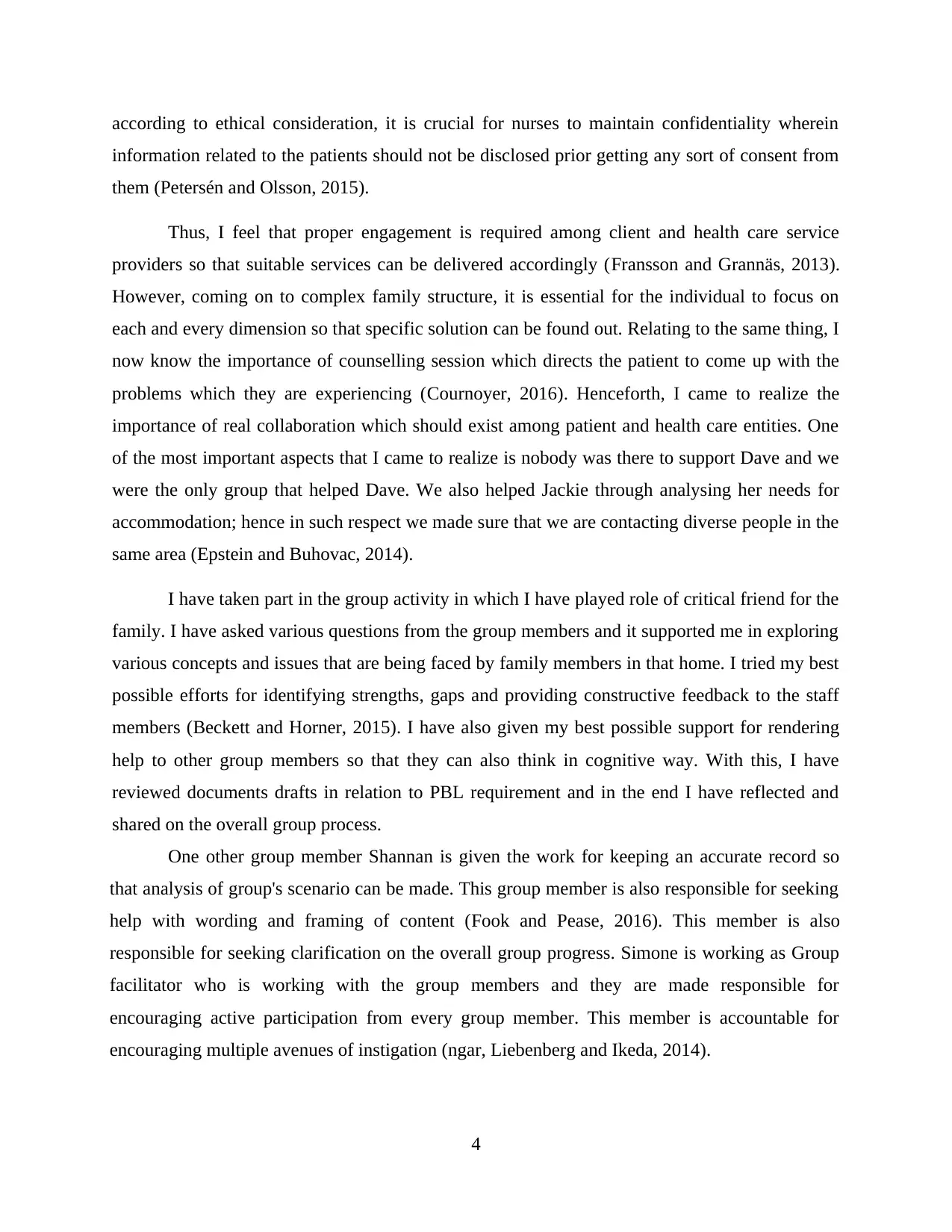
according to ethical consideration, it is crucial for nurses to maintain confidentiality wherein
information related to the patients should not be disclosed prior getting any sort of consent from
them (Petersén and Olsson, 2015).
Thus, I feel that proper engagement is required among client and health care service
providers so that suitable services can be delivered accordingly (Fransson and Grannäs, 2013).
However, coming on to complex family structure, it is essential for the individual to focus on
each and every dimension so that specific solution can be found out. Relating to the same thing, I
now know the importance of counselling session which directs the patient to come up with the
problems which they are experiencing (Cournoyer, 2016). Henceforth, I came to realize the
importance of real collaboration which should exist among patient and health care entities. One
of the most important aspects that I came to realize is nobody was there to support Dave and we
were the only group that helped Dave. We also helped Jackie through analysing her needs for
accommodation; hence in such respect we made sure that we are contacting diverse people in the
same area (Epstein and Buhovac, 2014).
I have taken part in the group activity in which I have played role of critical friend for the
family. I have asked various questions from the group members and it supported me in exploring
various concepts and issues that are being faced by family members in that home. I tried my best
possible efforts for identifying strengths, gaps and providing constructive feedback to the staff
members (Beckett and Horner, 2015). I have also given my best possible support for rendering
help to other group members so that they can also think in cognitive way. With this, I have
reviewed documents drafts in relation to PBL requirement and in the end I have reflected and
shared on the overall group process.
One other group member Shannan is given the work for keeping an accurate record so
that analysis of group's scenario can be made. This group member is also responsible for seeking
help with wording and framing of content (Fook and Pease, 2016). This member is also
responsible for seeking clarification on the overall group progress. Simone is working as Group
facilitator who is working with the group members and they are made responsible for
encouraging active participation from every group member. This member is accountable for
encouraging multiple avenues of instigation (ngar, Liebenberg and Ikeda, 2014).
4
information related to the patients should not be disclosed prior getting any sort of consent from
them (Petersén and Olsson, 2015).
Thus, I feel that proper engagement is required among client and health care service
providers so that suitable services can be delivered accordingly (Fransson and Grannäs, 2013).
However, coming on to complex family structure, it is essential for the individual to focus on
each and every dimension so that specific solution can be found out. Relating to the same thing, I
now know the importance of counselling session which directs the patient to come up with the
problems which they are experiencing (Cournoyer, 2016). Henceforth, I came to realize the
importance of real collaboration which should exist among patient and health care entities. One
of the most important aspects that I came to realize is nobody was there to support Dave and we
were the only group that helped Dave. We also helped Jackie through analysing her needs for
accommodation; hence in such respect we made sure that we are contacting diverse people in the
same area (Epstein and Buhovac, 2014).
I have taken part in the group activity in which I have played role of critical friend for the
family. I have asked various questions from the group members and it supported me in exploring
various concepts and issues that are being faced by family members in that home. I tried my best
possible efforts for identifying strengths, gaps and providing constructive feedback to the staff
members (Beckett and Horner, 2015). I have also given my best possible support for rendering
help to other group members so that they can also think in cognitive way. With this, I have
reviewed documents drafts in relation to PBL requirement and in the end I have reflected and
shared on the overall group process.
One other group member Shannan is given the work for keeping an accurate record so
that analysis of group's scenario can be made. This group member is also responsible for seeking
help with wording and framing of content (Fook and Pease, 2016). This member is also
responsible for seeking clarification on the overall group progress. Simone is working as Group
facilitator who is working with the group members and they are made responsible for
encouraging active participation from every group member. This member is accountable for
encouraging multiple avenues of instigation (ngar, Liebenberg and Ikeda, 2014).
4
Paraphrase This Document
Need a fresh take? Get an instant paraphrase of this document with our AI Paraphraser
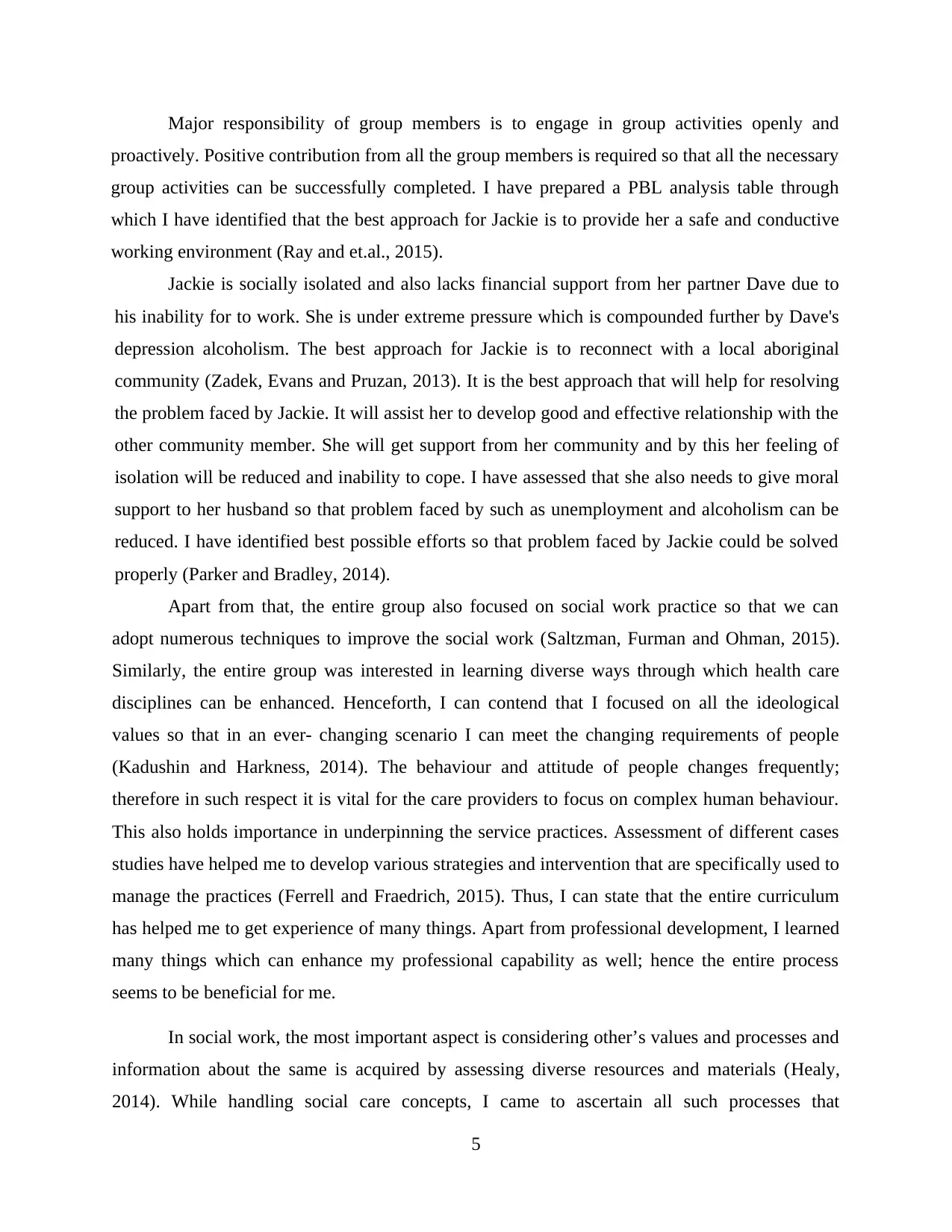
Major responsibility of group members is to engage in group activities openly and
proactively. Positive contribution from all the group members is required so that all the necessary
group activities can be successfully completed. I have prepared a PBL analysis table through
which I have identified that the best approach for Jackie is to provide her a safe and conductive
working environment (Ray and et.al., 2015).
Jackie is socially isolated and also lacks financial support from her partner Dave due to
his inability for to work. She is under extreme pressure which is compounded further by Dave's
depression alcoholism. The best approach for Jackie is to reconnect with a local aboriginal
community (Zadek, Evans and Pruzan, 2013). It is the best approach that will help for resolving
the problem faced by Jackie. It will assist her to develop good and effective relationship with the
other community member. She will get support from her community and by this her feeling of
isolation will be reduced and inability to cope. I have assessed that she also needs to give moral
support to her husband so that problem faced by such as unemployment and alcoholism can be
reduced. I have identified best possible efforts so that problem faced by Jackie could be solved
properly (Parker and Bradley, 2014).
Apart from that, the entire group also focused on social work practice so that we can
adopt numerous techniques to improve the social work (Saltzman, Furman and Ohman, 2015).
Similarly, the entire group was interested in learning diverse ways through which health care
disciplines can be enhanced. Henceforth, I can contend that I focused on all the ideological
values so that in an ever- changing scenario I can meet the changing requirements of people
(Kadushin and Harkness, 2014). The behaviour and attitude of people changes frequently;
therefore in such respect it is vital for the care providers to focus on complex human behaviour.
This also holds importance in underpinning the service practices. Assessment of different cases
studies have helped me to develop various strategies and intervention that are specifically used to
manage the practices (Ferrell and Fraedrich, 2015). Thus, I can state that the entire curriculum
has helped me to get experience of many things. Apart from professional development, I learned
many things which can enhance my professional capability as well; hence the entire process
seems to be beneficial for me.
In social work, the most important aspect is considering other’s values and processes and
information about the same is acquired by assessing diverse resources and materials (Healy,
2014). While handling social care concepts, I came to ascertain all such processes that
5
proactively. Positive contribution from all the group members is required so that all the necessary
group activities can be successfully completed. I have prepared a PBL analysis table through
which I have identified that the best approach for Jackie is to provide her a safe and conductive
working environment (Ray and et.al., 2015).
Jackie is socially isolated and also lacks financial support from her partner Dave due to
his inability for to work. She is under extreme pressure which is compounded further by Dave's
depression alcoholism. The best approach for Jackie is to reconnect with a local aboriginal
community (Zadek, Evans and Pruzan, 2013). It is the best approach that will help for resolving
the problem faced by Jackie. It will assist her to develop good and effective relationship with the
other community member. She will get support from her community and by this her feeling of
isolation will be reduced and inability to cope. I have assessed that she also needs to give moral
support to her husband so that problem faced by such as unemployment and alcoholism can be
reduced. I have identified best possible efforts so that problem faced by Jackie could be solved
properly (Parker and Bradley, 2014).
Apart from that, the entire group also focused on social work practice so that we can
adopt numerous techniques to improve the social work (Saltzman, Furman and Ohman, 2015).
Similarly, the entire group was interested in learning diverse ways through which health care
disciplines can be enhanced. Henceforth, I can contend that I focused on all the ideological
values so that in an ever- changing scenario I can meet the changing requirements of people
(Kadushin and Harkness, 2014). The behaviour and attitude of people changes frequently;
therefore in such respect it is vital for the care providers to focus on complex human behaviour.
This also holds importance in underpinning the service practices. Assessment of different cases
studies have helped me to develop various strategies and intervention that are specifically used to
manage the practices (Ferrell and Fraedrich, 2015). Thus, I can state that the entire curriculum
has helped me to get experience of many things. Apart from professional development, I learned
many things which can enhance my professional capability as well; hence the entire process
seems to be beneficial for me.
In social work, the most important aspect is considering other’s values and processes and
information about the same is acquired by assessing diverse resources and materials (Healy,
2014). While handling social care concepts, I came to ascertain all such processes that
5
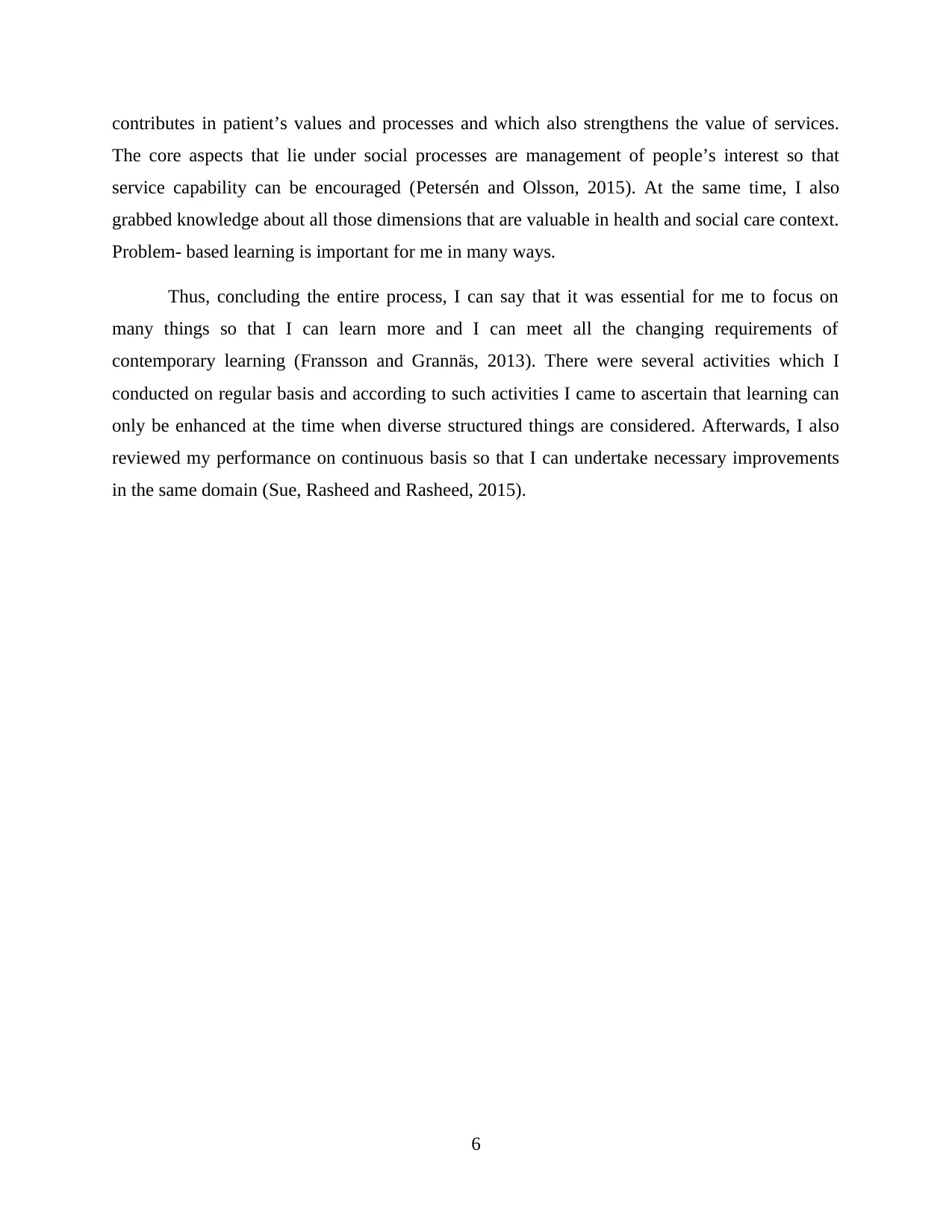
contributes in patient’s values and processes and which also strengthens the value of services.
The core aspects that lie under social processes are management of people’s interest so that
service capability can be encouraged (Petersén and Olsson, 2015). At the same time, I also
grabbed knowledge about all those dimensions that are valuable in health and social care context.
Problem- based learning is important for me in many ways.
Thus, concluding the entire process, I can say that it was essential for me to focus on
many things so that I can learn more and I can meet all the changing requirements of
contemporary learning (Fransson and Grannäs, 2013). There were several activities which I
conducted on regular basis and according to such activities I came to ascertain that learning can
only be enhanced at the time when diverse structured things are considered. Afterwards, I also
reviewed my performance on continuous basis so that I can undertake necessary improvements
in the same domain (Sue, Rasheed and Rasheed, 2015).
6
The core aspects that lie under social processes are management of people’s interest so that
service capability can be encouraged (Petersén and Olsson, 2015). At the same time, I also
grabbed knowledge about all those dimensions that are valuable in health and social care context.
Problem- based learning is important for me in many ways.
Thus, concluding the entire process, I can say that it was essential for me to focus on
many things so that I can learn more and I can meet all the changing requirements of
contemporary learning (Fransson and Grannäs, 2013). There were several activities which I
conducted on regular basis and according to such activities I came to ascertain that learning can
only be enhanced at the time when diverse structured things are considered. Afterwards, I also
reviewed my performance on continuous basis so that I can undertake necessary improvements
in the same domain (Sue, Rasheed and Rasheed, 2015).
6
⊘ This is a preview!⊘
Do you want full access?
Subscribe today to unlock all pages.

Trusted by 1+ million students worldwide
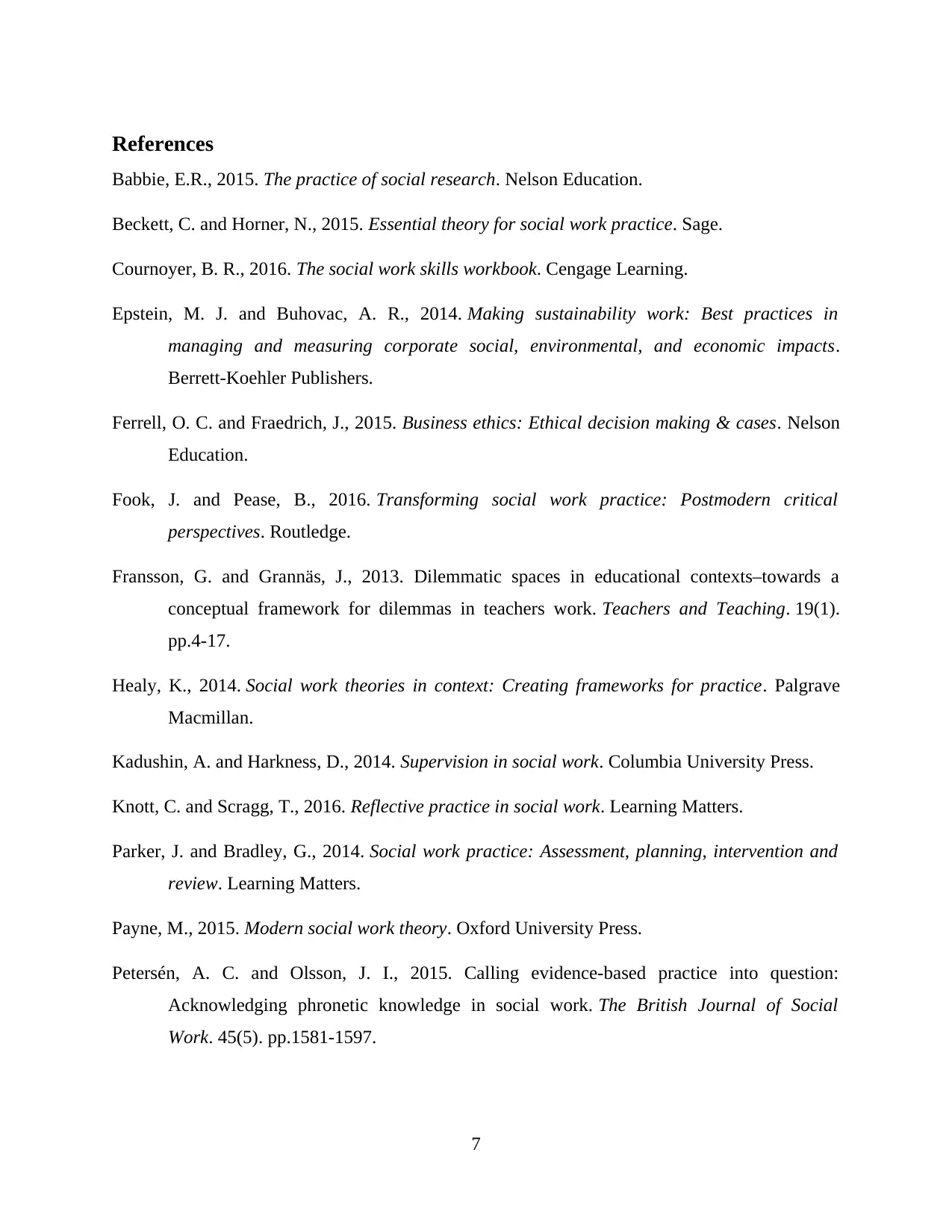
References
Babbie, E.R., 2015. The practice of social research. Nelson Education.
Beckett, C. and Horner, N., 2015. Essential theory for social work practice. Sage.
Cournoyer, B. R., 2016. The social work skills workbook. Cengage Learning.
Epstein, M. J. and Buhovac, A. R., 2014. Making sustainability work: Best practices in
managing and measuring corporate social, environmental, and economic impacts.
Berrett-Koehler Publishers.
Ferrell, O. C. and Fraedrich, J., 2015. Business ethics: Ethical decision making & cases. Nelson
Education.
Fook, J. and Pease, B., 2016. Transforming social work practice: Postmodern critical
perspectives. Routledge.
Fransson, G. and Grannäs, J., 2013. Dilemmatic spaces in educational contexts–towards a
conceptual framework for dilemmas in teachers work. Teachers and Teaching. 19(1).
pp.4-17.
Healy, K., 2014. Social work theories in context: Creating frameworks for practice. Palgrave
Macmillan.
Kadushin, A. and Harkness, D., 2014. Supervision in social work. Columbia University Press.
Knott, C. and Scragg, T., 2016. Reflective practice in social work. Learning Matters.
Parker, J. and Bradley, G., 2014. Social work practice: Assessment, planning, intervention and
review. Learning Matters.
Payne, M., 2015. Modern social work theory. Oxford University Press.
Petersén, A. C. and Olsson, J. I., 2015. Calling evidence-based practice into question:
Acknowledging phronetic knowledge in social work. The British Journal of Social
Work. 45(5). pp.1581-1597.
7
Babbie, E.R., 2015. The practice of social research. Nelson Education.
Beckett, C. and Horner, N., 2015. Essential theory for social work practice. Sage.
Cournoyer, B. R., 2016. The social work skills workbook. Cengage Learning.
Epstein, M. J. and Buhovac, A. R., 2014. Making sustainability work: Best practices in
managing and measuring corporate social, environmental, and economic impacts.
Berrett-Koehler Publishers.
Ferrell, O. C. and Fraedrich, J., 2015. Business ethics: Ethical decision making & cases. Nelson
Education.
Fook, J. and Pease, B., 2016. Transforming social work practice: Postmodern critical
perspectives. Routledge.
Fransson, G. and Grannäs, J., 2013. Dilemmatic spaces in educational contexts–towards a
conceptual framework for dilemmas in teachers work. Teachers and Teaching. 19(1).
pp.4-17.
Healy, K., 2014. Social work theories in context: Creating frameworks for practice. Palgrave
Macmillan.
Kadushin, A. and Harkness, D., 2014. Supervision in social work. Columbia University Press.
Knott, C. and Scragg, T., 2016. Reflective practice in social work. Learning Matters.
Parker, J. and Bradley, G., 2014. Social work practice: Assessment, planning, intervention and
review. Learning Matters.
Payne, M., 2015. Modern social work theory. Oxford University Press.
Petersén, A. C. and Olsson, J. I., 2015. Calling evidence-based practice into question:
Acknowledging phronetic knowledge in social work. The British Journal of Social
Work. 45(5). pp.1581-1597.
7
Paraphrase This Document
Need a fresh take? Get an instant paraphrase of this document with our AI Paraphraser
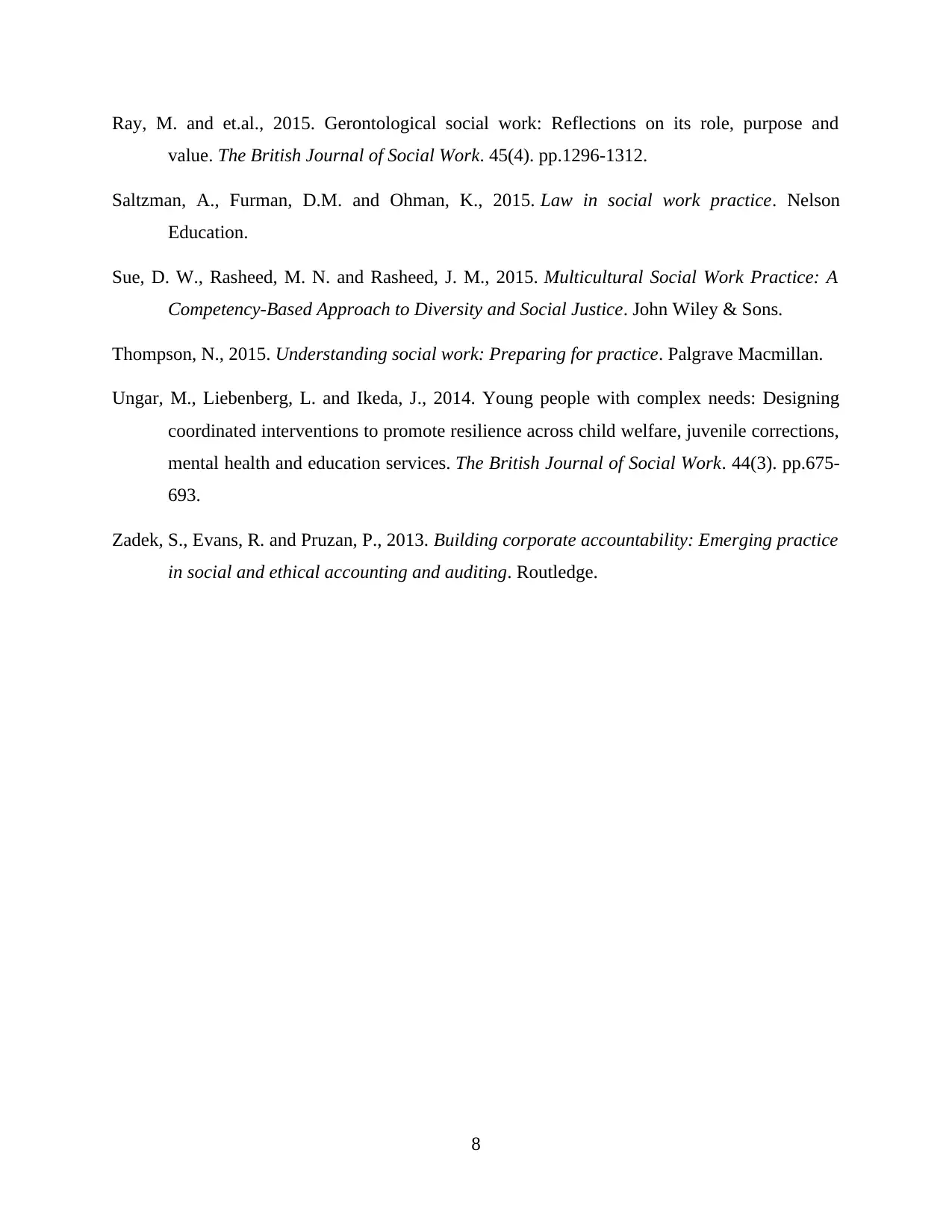
Ray, M. and et.al., 2015. Gerontological social work: Reflections on its role, purpose and
value. The British Journal of Social Work. 45(4). pp.1296-1312.
Saltzman, A., Furman, D.M. and Ohman, K., 2015. Law in social work practice. Nelson
Education.
Sue, D. W., Rasheed, M. N. and Rasheed, J. M., 2015. Multicultural Social Work Practice: A
Competency-Based Approach to Diversity and Social Justice. John Wiley & Sons.
Thompson, N., 2015. Understanding social work: Preparing for practice. Palgrave Macmillan.
Ungar, M., Liebenberg, L. and Ikeda, J., 2014. Young people with complex needs: Designing
coordinated interventions to promote resilience across child welfare, juvenile corrections,
mental health and education services. The British Journal of Social Work. 44(3). pp.675-
693.
Zadek, S., Evans, R. and Pruzan, P., 2013. Building corporate accountability: Emerging practice
in social and ethical accounting and auditing. Routledge.
8
value. The British Journal of Social Work. 45(4). pp.1296-1312.
Saltzman, A., Furman, D.M. and Ohman, K., 2015. Law in social work practice. Nelson
Education.
Sue, D. W., Rasheed, M. N. and Rasheed, J. M., 2015. Multicultural Social Work Practice: A
Competency-Based Approach to Diversity and Social Justice. John Wiley & Sons.
Thompson, N., 2015. Understanding social work: Preparing for practice. Palgrave Macmillan.
Ungar, M., Liebenberg, L. and Ikeda, J., 2014. Young people with complex needs: Designing
coordinated interventions to promote resilience across child welfare, juvenile corrections,
mental health and education services. The British Journal of Social Work. 44(3). pp.675-
693.
Zadek, S., Evans, R. and Pruzan, P., 2013. Building corporate accountability: Emerging practice
in social and ethical accounting and auditing. Routledge.
8
1 out of 8
Related Documents
Your All-in-One AI-Powered Toolkit for Academic Success.
+13062052269
info@desklib.com
Available 24*7 on WhatsApp / Email
![[object Object]](/_next/static/media/star-bottom.7253800d.svg)
Unlock your academic potential
Copyright © 2020–2025 A2Z Services. All Rights Reserved. Developed and managed by ZUCOL.





